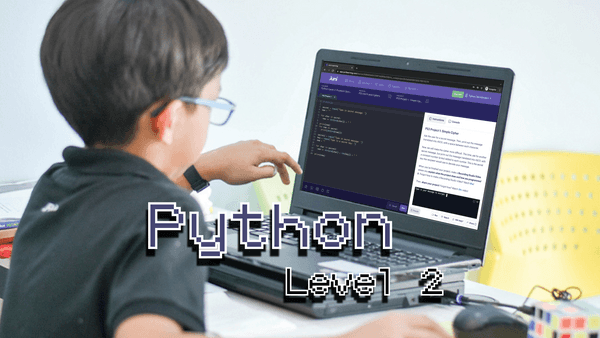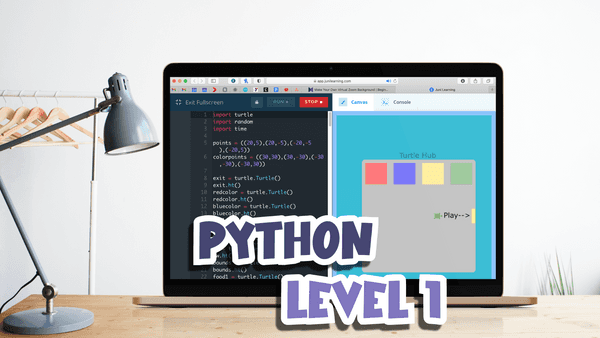Python Level 2: Problem Solver
Watch them level up while they build Blackjack and other games. In this course, learners solve more complex programming problems and progress through Python fundamentals. They’re on their way to Python fluency. This 1:1 course features individualized lesson planning.

- Private 1:1
- Format
- Age 12-18
- Learners
- Weekly
- Classes
- 50 minutes
- Per class

About this Course
Python Level 2 gives students the opportunity to apply their knowledge to more complex coding problems. By the end of the course, students will feel comfortable and confident using ciphers, sets, conditional statements, and dictionaries to solve more difficult coding challenges. With guidance from a personalized Juni instructor, students will build exciting projects like their own calculator, a text sentiment tool, and a virtual Blackjack game.
Billing
Billed as
$275 / month
Scheduling
1:1 classes are 50 minutes long and can be scheduled anytime Monday-Sunday from 7am to 7pm PT. To begin, select Book your Placement Class to signup. Our team will then match you and set up your first class!
- Course duration4-6 months
- Lesson50 minutes
Learning Targets
Variables
Variables-1: I know what a variable is and when to use a variable in my code
Variables-2: I can create a variable and assign it a value in Python
Variables-3: I can print out a variable in Python
Variables-4: I understand the difference between a string and an integer
Variables-5: I can use the str() function correctly in Python
Variables-6: I can ask for user input in Python
Variables-7: I can use the len() function correctly in Python
Variables-8: I can access the ith character in a string in Python
Variables-9: I can concatenate strings in Python
Loops
Loops-1: I know what a loop is and when to use a loop in my code
Loops-2: I know the difference between a for loop and a while loop and when to use each in my code
Loops-3: I can write a for loop in Python using 'for i in range():' syntax
Loops-4: I can use a for loop in Python to access characters in a string
Loops-5: I can write a for loop in Python with a specified starting point, ending point, and increment
Loops-6: I can write a while loop in Python
Loops-7: I can use a while loop in Python to access characters in a string
Loops-8: I understand when and how to use a while True loop in Python
Conditionals
Conditionals-1: I know what a conditional statement is
Conditionals-2: I can write an 'if' statement in Python
Conditionals-3: I can use 'and' statements logically to check multiple conditions in Python
Conditionals-4: I can use 'or' statements logically to check multiple conditions in Python
Conditionals-5: I understand how and when to use 'elif' statements in Python
Conditionals-6: I understand how and when to use 'else' statements in Python
Conditionals-7: I can write nested 'if' statements in Python
Functions
Functions-1: I understand what functions are and what they are used for
Functions-2: I can define a function in Python using parameters as necessary
Functions-3: I can define a function with an output in Python
Functions-4: I can call a function in Python, specifying parameters where necessary
Functions-5: I can use the output of a function in my code in Python
Lists
Lists-1: I know what a list is and when to use a list in code
Lists-2: I can create an empty list in Python
Lists-3: I can use the append() and remove() functions correctly with lists in Python
Lists-4: I can access and interact with each item in a list in Python
Lists-5: I can iterate through a list in Python
Lists-6: I can add items to a list using a loop in Python
Dictionaries
Dictionaries-1: I understand what a dictionary is
Dictionaries-2: I can create a dictionary in Python
Dictionaries-3: I can access a value in a dictionary in Python
Dictionaries-4: I can add a key-value pair to a dictionary in Python
Dictionaries-5: I can iterate through a dictionary in Python
Dictionaries-6: I can check whether an item exists in a dictionary in Python
Dictionaries-7: I can add items to a dictionary using a loop in Python
Sets
Sets-1: I understand what a set is
Sets-2: I can create an empty set in Python
Sets-3: I can use the add() and remove() functions correctly with sets in Python
Sets-4: I can use the union() function correctly in Python
Sets-5: I can use the intersection() function correctly in Python
Sets-6: I can check whether an item exists in a set in Python
Sets-7: I can add items to a set using a loop in Python
Computer Science Habits
I use spacing and logical variable names to improve my code's readability
I regularly comment my code to improve my code's readability
I appropriately and frequently test my code
I can independently debug my code
I can independently determine which data structures are best for a project
General Learning Habits
Joyful Collaboration
- I practice listening to my instructor and sharing my ideas to co-create understanding.
- I attempt tasks independently and ask my instructor questions when I need help.
Unlimited Curiosity
- I take ownership of my learning by asking meaningful questions both when I need clarification and when I want to know more about a topic.
Nimble Determination
- I practice resilience when I am frustrated that I have not yet achieved mastery of a new concept or skill; instead of complaining about challenges, I try new approaches and creative solutions.
Invest in Excellence
- I arrive to class on time and prepared to learn, with my computer set up with a strong internet connection.
- I complete my homework on time, and if I cannot complete my homework due to other obligations, I honestly communicate the reasons for late homework to my instructor.
- I do my best to stay present and on task for the whole session. I support my focus by putting away any distracting technology and setting notifications on my device to “do not disturb” mode.
Homework
Instructors will assign students roughly 60 minutes of project related homework at the end of each session. Homework is designed to complement the class experience and ensure the student continues to gain practical experience outside of the session.
Pre-Requisites
Completion of Python Level 1

Python Level 2 gives students the opportunity to apply their knowledge to more complex coding problems. By the end of the course, students will feel comfortable and confident using ciphers, sets, conditional statements, and dictionaries to solve more difficult coding challenges. With guidance from a personalized Juni instructor, students will build exciting projects like their own calculator, a text sentiment tool, and a virtual Blackjack game.
Who are Juni’s Instructors?
Our instructors are subject matter experts from top US universities. Instructors are highly-vetted and background checked prior to joining and undergo extensive training before ever teaching on our platform.
Upon signing up, parents are asked a series of questions that allow us to match your child with an optimal instructor based on their unique needs and interests. Factors that are considered in our matching process include Learning Style, Personality, Personal Experience, and Academic & Career Aspiration.





